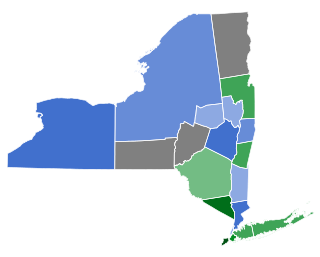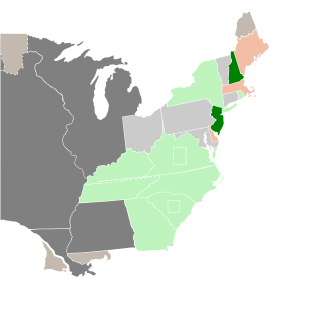The 1802 United States Senate special election in New York was held on February 9, 1802, by the New York State Legislature to elect a U.S. Senator (Class 3) to represent the State of New York in the United States Senate.
The 1802 United States Senate special election in New York was held on February 9, 1802, by the New York State Legislature to elect a U.S. Senator (Class 3) to represent the State of New York in the United States Senate.
John Armstrong had been re-elected in January 1801 to a full term (1801–1807), but resigned on February 5, 1802. At the last state election, George Clinton had been elected Governor again, serving now his seventh term, and his Democratic-Republican Party had won a large majority to the Assembly which could outvote the small Federalist Senate majority in a joint ballot. Aaron Burr accused the Clintons later to have hatched a scheme to seat DeWitt Clinton, the governor's nephew, in the U.S. Senate. Burr affirmed that Thomas Tillotson, a brother-in-law of Chancellor Robert R. Livingston like Armstrong, was appointed Secretary of State of New York in 1801 as part of a deal which required Tillotson to procure Armstrong's resignation.
At the State election in April 1801, the Democratic-Republican Party won a large majority in the Assembly, and half of the 12 State Senate seats up for renewal. The 25th New York State Legislature met from January 26 to April 5, 1802, at Albany, New York.
State Senator DeWitt Clinton ran as the candidate of the Democratic-Republican Party.
Ex-State Senator (1794–1795) Matthew Clarkson was the Federalist candidate.
Clarkson was nominated by the Senate, Clinton by the Assembly. The Legislature then proceeded to a joint ballot, and Clinton was elected. This was the first time that a joint ballot was necessary to choose between the nominees of different majorities in the houses of the Legislature.
| Office | House | Democratic-Republican | Federalist | ||
|---|---|---|---|---|---|
| U.S. Senator | State Senate (44 members) | DeWitt Clinton | 16 | Matthew Clarkson | 19 |
| State Assembly (107 members) | DeWitt Clinton | 68 | Matthew Clarkson | 28 | |
| Joint ballot (151 members) | DeWitt Clinton | 82 | Matthew Clarkson | 45 | |
Clinton took his seat on February 23, 1802, but resigned on November 4, 1803, and Armstrong was appointed by Governor Clinton to re-take his former seat. In February 1804, a special election was held by the State Legislature to fill both seats in the U.S. Senate and, either due to a mistake or to give Armstrong two more years to serve, Armstrong was then elected to the Class 1 seat (term 1803–1809), and John Smith to the Class 3 seat (term 1801–1807) on which Clinton and Armstrong had sat. Armstrong set a record that still stands after more than 200 years, presenting four different credentials to take a seat in the U.S. Senate within as many years, being three times elected and once appointed. Armstrong resigned his seat again on June 30, 1804, after his appointment as U.S. Minister to France.
New York is a Democratic stronghold and is considered one of the "Big Three" Democratic strongholds alongside California and Illinois. The following table indicates the party of elected officials in the U.S. state of New York:

The 1792 New York gubernatorial election was held in April 1792 to elect the Governor and Lieutenant Governor of New York. Incumbent governor George Clinton was narrowly re-elected to a sixth term in office over John Jay, after the votes of Clinton, Ostego, and Tioga counties were disqualified on technicalities.

The 1804 New York gubernatorial election was held in April 1804 to elect the Governor of New York. Incumbent Governor George Clinton did not run for re-election, having been nominated for Vice President of the United States in February. In a campaign that blurred partisan divisions, Morgan Lewis defeated Aaron Burr by a landslide margin.
The second 1800 United States Senate special election in New York was held on November 6, 1800, by the New York State Legislature to elect a U.S. Senator to represent the State of New York in the United States Senate.
The 1801 United States Senate election in New York was held on January 27, 1801, by the New York State Legislature to elect a U.S. Senator to represent the State of New York in the United States Senate.

The 1803 United States Senate election in New York was held on February 1, 1803, by the New York State Legislature to elect a U.S. Senator to represent the State of New York in the United States Senate.
The first 1804 United States Senate special election in New York was held on February 3, 1804, by the New York State Legislature to elect two United States Senators to represent the State of New York in the United States Senate.

The 1807 United States Senate election in New York was held on February 3, 1807, by the New York State Legislature to elect a United States Senator to represent the State of New York in the United States Senate.

The 1813 United States Senate election in New York was held on February 2, 1813, by the New York State Legislature to elect a U.S. Senator to represent the State of New York in the United States Senate.

The 1819/1820 United States Senate election in New York was held on February 2, 1819, and January 8, 1820, by the New York State Legislature to elect a U.S. Senator to represent the State of New York in the United States Senate.

The 1804–05 United States Senate elections were held on various dates in various states. As these U.S. Senate elections were prior to the ratification of the Seventeenth Amendment in 1913, senators were chosen by state legislatures. Senators were elected over a wide range of time throughout 1804 and 1805, and a seat may have been filled months late or remained vacant due to legislative deadlock. In these elections, terms were up for the senators in Class 2.

The 1790–91 United States Senate elections were held on various dates in various states. These U.S. Senate elections occurred during the first midterm election cycle, which took place in the middle of President George Washington's first term. As these elections were prior to the ratification of the Seventeenth Amendment in 1913, senators were chosen by state legislatures. Senators were elected over a wide range of time throughout 1790 and 1791, and a seat may have been filled months late or remained vacant due to legislative deadlock. In these elections, terms were up for the nine senators in Class 1.

The 1802–03 United States Senate elections were held on various dates in various states. As these U.S. Senate elections were prior to the ratification of the Seventeenth Amendment in 1913, senators were chosen by state legislatures. Senators were elected over a wide range of time throughout 1802 and 1803, and a seat may have been filled months late or remained vacant due to legislative deadlock. In these elections, terms were up for the senators in Class 1.

The 14th New York State Legislature, consisting of the New York State Senate and the New York State Assembly, met from January 5 to March 24, 1791, during the fourteenth year of George Clinton's governorship, in New York City.

The 25th New York State Legislature, consisting of the New York State Senate and the New York State Assembly, met from January 26 to April 5, 1802, during the first year of George Clinton's second tenure as Governor of New York, in Albany.

The 27th New York State Legislature, consisting of the New York State Senate and the New York State Assembly, met from January 31 to April 11, 1804, during the third year of George Clinton's second tenure as Governor of New York, in Albany.

The 28th New York State Legislature, consisting of the New York State Senate and the New York State Assembly, met from November 6, 1804, to April 10, 1805, during the first year of Morgan Lewis's governorship, in Albany.

The 29th New York State Legislature, consisting of the New York State Senate and the New York State Assembly, met from January 28 to April 7, 1806, during the second year of Morgan Lewis's governorship, in Albany.

The 36th New York State Legislature, consisting of the New York State Senate and the New York State Assembly, met from November 3, 1812, to April 13, 1813, during the sixth year of Daniel D. Tompkins's governorship, in Albany.

The 42nd New York State Legislature, consisting of the New York State Senate and the New York State Assembly, met from January 5 to April 13, 1819, during the second year of DeWitt Clinton's governorship, in Albany.